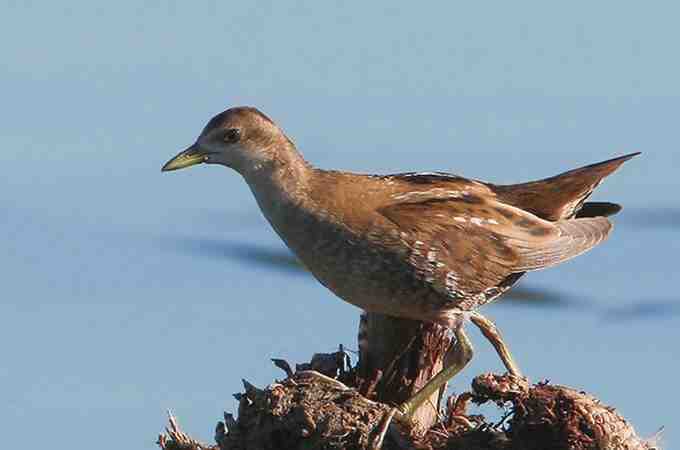Zapornia parva
IUCN
LCBasic Information
Scientific classification
- name:Zapornia parva
- Scientific Name:Zapornia parva,Porzana parva,Little Crake
- Outline:Wading birds
- Family:Gruiformes Railidae Lagomorpha
Vital signs
- length:18-20cm
- Weight:35-50g
- lifetime:About 3-7 years
Feature
Green bill, red base, dark green feet
Distribution and Habitat
Distributed in Albania, Algeria, Armenia, Austria, Azerbaijan, Bahrain, Belarus, Belgium, Bosnia and Herzegovina, Bulgaria, China, Croatia, Cyprus, Czech Republic, Egypt, Estonia, Ethiopia, Finland, France, Georgia, Germany, Greece; Hungary, India, Islamic Republic of Iran, Iraq, Israel, Italy, Jordan, Kazakhstan, Kuwait, Kyrgyzstan, Latvia, Lebanon, Libya, Lithuania, Macedonia, Malta, Mauritania, Moldova, Montenegro, Morocco, Netherlands, Nigeria, Oman, Pakistan, Palestine, Poland, Romania, Saudi Arabia, Senegal, Serbia, Slovakia, Slovenia, Spain, Sudan, Sweden, Switzerland, Syrian Arab Republic, Tajikistan, Tunisia, Turkey, Turkmenistan, Ukraine, Uzbekistan, Yemen, Zambia.
Migratory bird: Afghanistan, Cape Verde, Denmark, Eritrea, Gambia, Ireland, Liberia, Luxembourg, Niger, Norway, Portugal, Qatar, Somalia, Uganda, United Arab Emirates, United Kingdom.
It inhabits lakes, rivers, ponds, canals and deep swamps rich in reeds and aquatic plants in forests, plains, deserts, and mou
Appearance
Himeda chicken is a small wading bird, with a body length of 18-20 cm. The summer feathers of the male bird are dark brown from the top of the head to the back of the neck, olive brown on the back and shoulders, with broad black stripes and some narrow white horizontal spots. The flight feathers are brown. The waist and tail feathers are dark brown. The forehead, side of the head, and the entire lower body, including the cheeks, throat, front neck, and sides of the neck are all slate gray, with less obvious white horizontal stripes on the sides, or no horizontal spots. The eyes are red, and the cheeks and throat of winter feathers are white. The plumage color of the female bird's upper body is similar to that of the male bird, but the lower body is yellow, and the lower tail coverts have brown and white horizontal spots. The irises of both male and female birds are red, the beak is green, the base is red, and the feet are dark green.
Size measurement: body length 180-200 mm; mo
Details
Little Crake is a small wading bird with no subspecies.

The frog often moves alone or in family groups. It is good at swimming and diving. It often swims among the reeds and water grass in the pond. Sometimes it also moves outside the reeds or on the water surface far from the shore, especially in the morning and evening. It can also climb along the reed poles or walk and run briskly on the reeds. It likes to sing when it is active. When it encounters danger, it often runs on the reeds or swims quickly into the reeds to escape from the enemy. It rarely takes off. Even if it takes off, it usually does not fly far and hides in the reeds or water grass. It has a mixed diet, mainly feeding on small aquatic animals, moth larvae, insects, spiders, snails and other animal foods, and also eats young shoots, fruits and seeds of plants. When foraging, it mainly swims on the water surface, pecking at insects on the water surface and plants, and sometimes dives for food.
The frog breeds in southern and eastern Europe, central Asia, central Russia and the Tarim River and Tianshan Mountains in western Xinjiang, my country, and hibernates in the Mediterranean coast of Africa, western Asia and northwestern India. It is a summer migratory bird in China. It begins to migrate to China in late March and early April in spring; it leaves in mid-to-late October in autumn.
The breeding season of the terrapin is from May to July, and the mate is one male and one female. Each pair nests alone, usually in lakes rich in reeds and water plants, deep reed ponds, canals and river bends. The nest is placed in the reeds and water plants near the shore with a certain depth of water. Most of them are fixed on the reed stems on the water surface or on small willow trees in the water, and the bottom of the nest is close to the water surface. Occasionally, there are nests on the ground. The shape of the nest is bowl-shaped, mainly composed of dry reed stems and leaves and water plants. The male and female birds build the nest together, and each nest lays 7-8 eggs, occasionally as few as 6 and as many as 9. The color of the eggs is light yellow-gray, with brown or rust spots. After the eggs are laid, they begin to incubate, and the parents take turns to do it. The incubation period is 20-21 days.
Listed in the 2013 Red List of Endangered Species of the World Conservation Union (IUCN) ver 3.1 - Least Concern (LC).
Listed in the second level of the "List of National Key Protected Wildlife in China".
Protect wildlife and eliminate game.
Maintaining ecological balance is everyone's responsibility!








